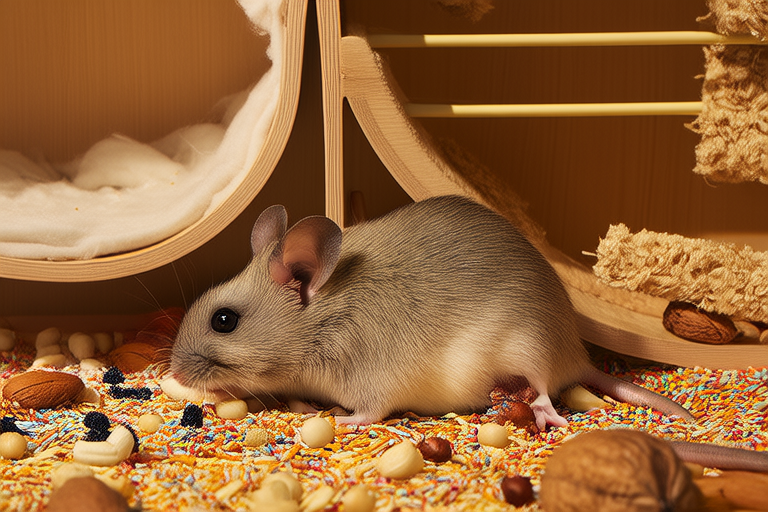How to Create the Ultimate Habitat for Your Fancy Rat Pal
Welcome to the world of fancy rat companionship! Rats are intelligent, social creatures that thrive on stimulation and care. Creating the perfect habitat is crucial to ensuring your rat’s physical and mental well-being. This guide will walk you through setting up an ideal living space for your fancy rat pal, covering everything from cage size and bedding to toys, exercise, and diet.
The Perfect Cage Size
The first step in creating a fantastic habitat is choosing the right cage. The cage should be spacious enough for your rat to move around comfortably. A general rule of thumb is that the cage should provide at least three square feet of floor space per rat. Vertical space is also important, as rats love to climb and explore. Multi-level cages with ramps or platforms can offer more room and enrich the environment.
Bedding Options
Selecting the right bedding is vital for your rat’s comfort and health. Avoid cedar and pine shavings, as they can cause respiratory issues. Instead, opt for aspen shavings, paper-based bedding, or recycled paper products. These materials are softer, safer, and easier on your rat’s lungs. Ensure the bedding is absorbent and changes frequently to prevent ammonia buildup and odors.
Toys for Enrichment
Rats are curious and playful animals that require mental and physical stimulation. Toys can help alleviate boredom and promote healthy behavior. Consider providing chew toys made from untreated wood, cardboard tubes, or rattan balls. These items not only entertain your rat but also help maintain dental health by allowing them to gnaw naturally. Puzzle feeders, which release treats when manipulated, encourage problem-solving and cognitive engagement.
Hiding Spots and Comfort Zones
Rats are naturally shy and need a safe place to retreat. Incorporate cozy hideouts such as small boxes, tunnels, or commercially available rat igloos. These hideouts provide a sense of security and privacy, reducing stress and promoting relaxation. Place the hideouts in various locations within the cage to encourage exploration and create different areas within the habitat.
Exercise Wheels
Adequate exercise is crucial for maintaining your rat’s physical health. An exercise wheel is an excellent addition to the cage. Look for solid-surface wheels, as these prevent injuries that can occur from falling through wire mesh. Ensure the wheel is large enough for your rat to run comfortably without hunching or straining. Regular exercise helps keep your rat active and prevents obesity.
Proper Ventilation
Good air circulation is essential for your rat’s respiratory health. Ensure the cage has adequate ventilation, but avoid placing it near drafts or direct sunlight. If the cage has a wire top, consider adding a mesh cover to prevent escape while still allowing airflow. Proper ventilation helps maintain clean air and reduces the risk of respiratory infections.
Safety Considerations
When setting up your rat’s habitat, prioritize safety. Check the cage for any sharp edges or protrusions that could harm your rat. Avoid using materials containing lead or other toxic substances. Ensure all parts of the cage are secure to prevent escapes. Supervise your rat during playtime outside the cage to prevent accidents. Additionally, keep the cage away from other pets that might pose a threat.
Cleaning Routines
Regular cleaning is necessary to maintain a healthy environment for your rat. Clean the cage thoroughly once a week, replacing all bedding and scrubbing surfaces with pet-safe disinfectants. Spot clean daily to remove soiled bedding and uneaten food. Keep the water bottle and food dishes clean and replace water regularly. A clean habitat promotes good hygiene and reduces the risk of illness.
Dietary Needs Integration Within the Habitat
Your rat’s diet should be balanced and nutritious. Incorporate fresh fruits, vegetables, and grains into their diet alongside high-quality commercial rat pellets. Scatter feeding encourages foraging behavior, simulating natural hunting instincts. Place food dishes in various locations within the cage to stimulate exploration and prevent boredom. Providing a variety of textures and flavors in their diet ensures a well-rounded nutritional intake.
Environmental Enrichment Ideas
Creating a stimulating environment is key to your rat’s happiness. Introduce novel objects periodically to keep things interesting. Rotate toys and add new elements to the cage to encourage exploration. Create tunnels or build obstacle courses using cardboard boxes or tunnels. Offer different types of bedding or nesting materials to vary the texture and scent. These changes provide mental stimulation and prevent monotony.
Tips for Setting Up a Stimulating Yet Safe Environment
- Simulate Natural Behaviors: Provide opportunities for climbing, digging, and exploring. Use ramps, platforms, and tunnels to mimic their natural habitat.
- Encourage Social Interaction: If you have multiple rats, provide ample space and resources to minimize competition and stress.
- Monitor Health: Regularly check your rat for signs of illness, including lethargy, loss of appetite, or unusual behavior. Early intervention is crucial for maintaining good health.
- Promote Dental Health: Provide plenty of chew toys to help wear down teeth and prevent overgrowth.
By following these guidelines, you can create a stimulating yet safe environment that mimics their natural behaviors and enhances the quality of life for your fancy rat pal. With careful planning and attention to detail, your rat will enjoy a happy, healthy habitat that fosters both physical and mental well-being.
